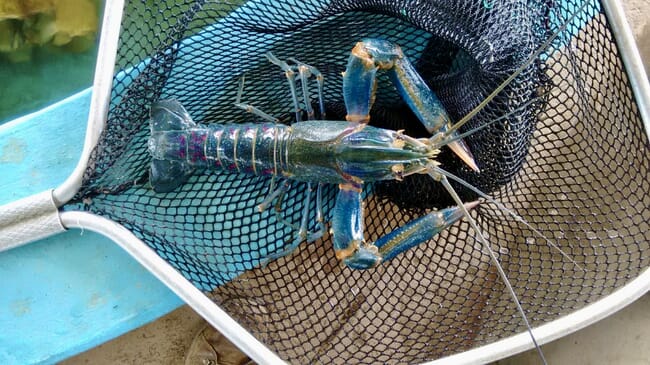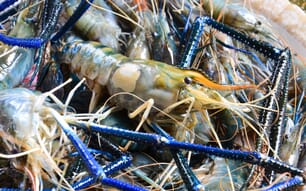Can you tell me a bit about your aquaculture background?
After gaining masters degrees in both biology and sustainable aquaculture I managed Goatsbridge Trout Farm in Ireland, before joining Seafresh Group as its environmental and social sustainability technologist.

What inspired you to farm crayfish?
Redclaw (Cherax quadricarinatus), is a special species of crayfish that grows to the size of small lobster and is renowned for its taste, texture and amazing blue colour, turning dark red after cooking. It makes for a real treat if you are looking for something special for your dinner and has twice the tail meat of other crayfish species. We are aiming to harvest them at 100g, a size that means most people would want two for a main course.
With much of the world’s best lobster now going to China – their lobster imports have risen by 190 percent in eight years – we want to bring to a valid alternative to the European market that can make people feel they are having something truly special.
We’re developing an environmentally friendly technology to produce redclaw year-round for high end restaurants with a stable and high quality product that they can rely on. Our technology was developed with high animal welfare standards in mind to ensure that our crayfish are handled in the best way from hatch to harvest.
We have received a lot of interest from distributors specialising in high quality premium seafood and we decided to partner with Wild Harbour Ltd since our values align.

© Noola Redclaw
What are the challenges – from a husbandry perspective – of crayfish production in an RAS?
While the species is fairly widespread in the wild, the only information available comes from culturing them in ponds, in Queensland. Because of the different conditions in ponds we need to develop knowledge on how to produce them in RAS. However, we have a net advantage since one of our board members, Josh McNally, was previously head of the biggest redclaw farm in Australia and also has experience of RAS construction.
Who are the other members of the team?
Unusually for this sector we’re a mainly female team. Only 4 percent of global seafood businesses are run by women, so we are an anomaly. We also have a female production manager, Rio Lightowler, who previously managed the Dorset Cleanerfish hatchery. And our other board member is Marcella Navarra, CEO of Project X Global - a WWF-funded corporate accelerator. We’re now looking for one more board member – someone who has experience of commercialising agricultural products and has links to the hotel / catering sectors.
Why did you choose to locate in Dorset?
Dorset Council has made a commitment to support the development of the aquaculture sector to generate quality jobs and opportunities for employment in the county. They not only helped with connections on the ground and access to bid writing services, but they also allowed us to lease a perfect start-up site.
How have you financed the project to date and how much more funding are you looking to raise?
Noola Redclaw has been developed so far through a combination of grants and self-financing. We were recently awarded a £60,000 grant by the Fisheries and Seafood Innovation Scheme, which will allow us to get started and decrease the initial capital risk.
We have received pre-approval for the Seed Enterprise Investment Scheme (SEIS), which means that any UK taxpayers who invest in us will get at least 50 percent of their investment back in the form of tax relief. We are currently looking to raise £140,000 in our first investment round, which would enable us to run a pilot farm for 18 months, during which time we will verify our projections related to breeding, hatchery and grow-out, as well as build our pedigree line.
This is will set us up to become a fully-integrated company, able to control the biggest supply chain risks. Over the course of 18 months we can produce four cycles of crayfish, which will allow us to not only verify but also refine our process and proceed to IP protection if we decide to.
When do you aim to start construction / send your first product to market?
We are starting construction right now and should have something small but operational before Christmas, which is very exciting. We then aim to close our investment round by the end of January and complete the construction, which will allow to get to market with the first batch by the summer of 2022.
How do you plan to expand once your pilot project has been validated?
We’ve already completed a feasibility study for the creation of a commercial-scale production facility and have identified two possible locations in the UK for this – both of which would be able to provide 100 renewable energy. We’re also considering a location in Southern Europe.
Either way, the current location will remain our headquarters and the site of our breeding programme and we are looking forward to developing our own unique strain of redclaw in partnership with a genetics company. We believe that there are high levels of inbreeding in the Australian redclaw aquaculture sector and are looking to professionalise production.
In terms of the volumes we are likely to produce I don’t want to give a figure at this stage, but I will say that we are going to remain niche producers and keep away from the commodity market. Our brand will soon be registered and we will be producing a unique and limited product.




